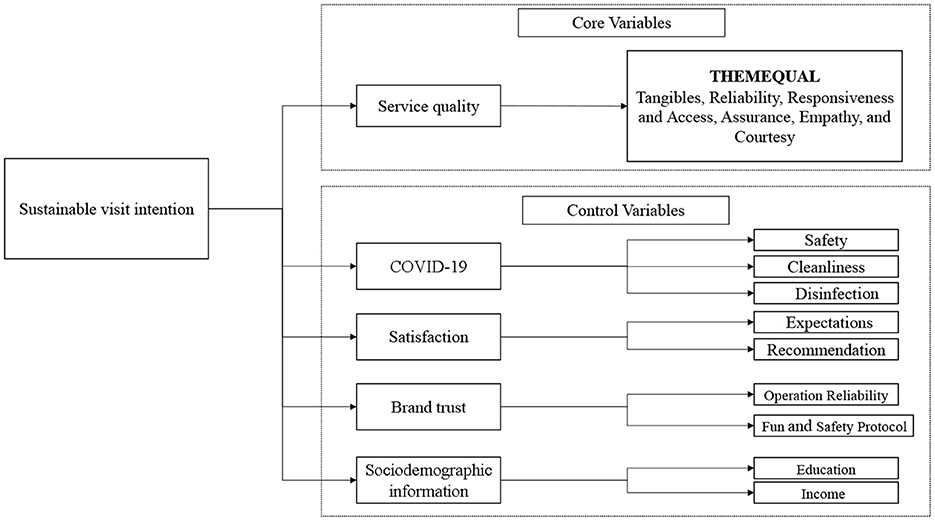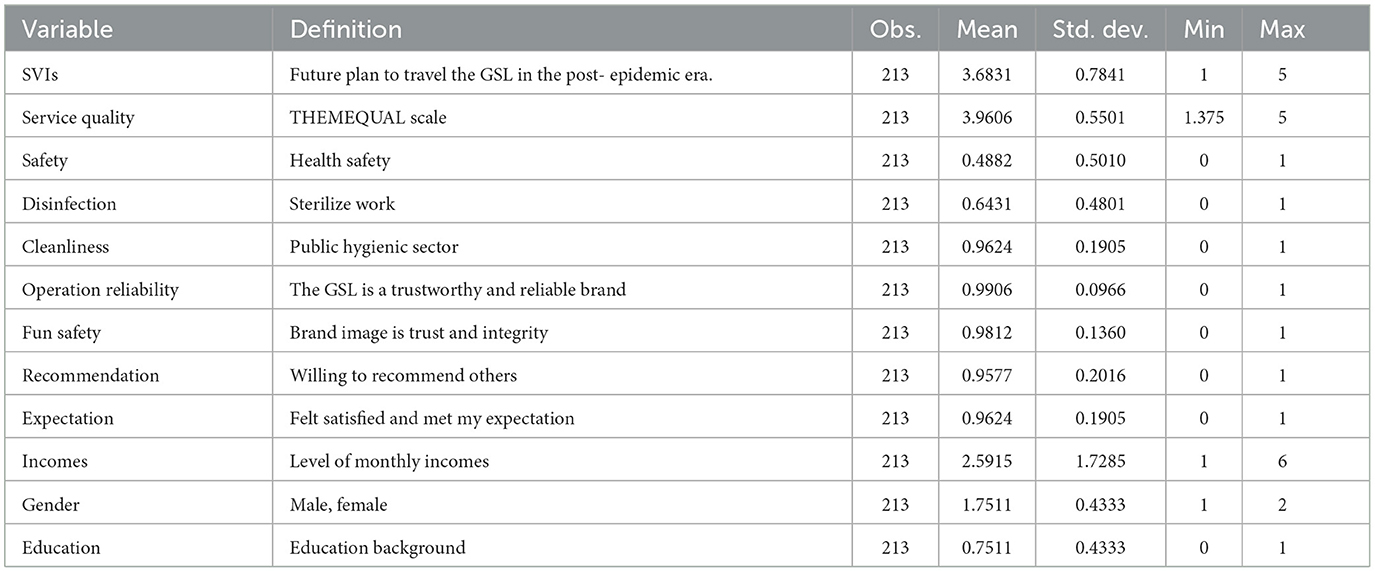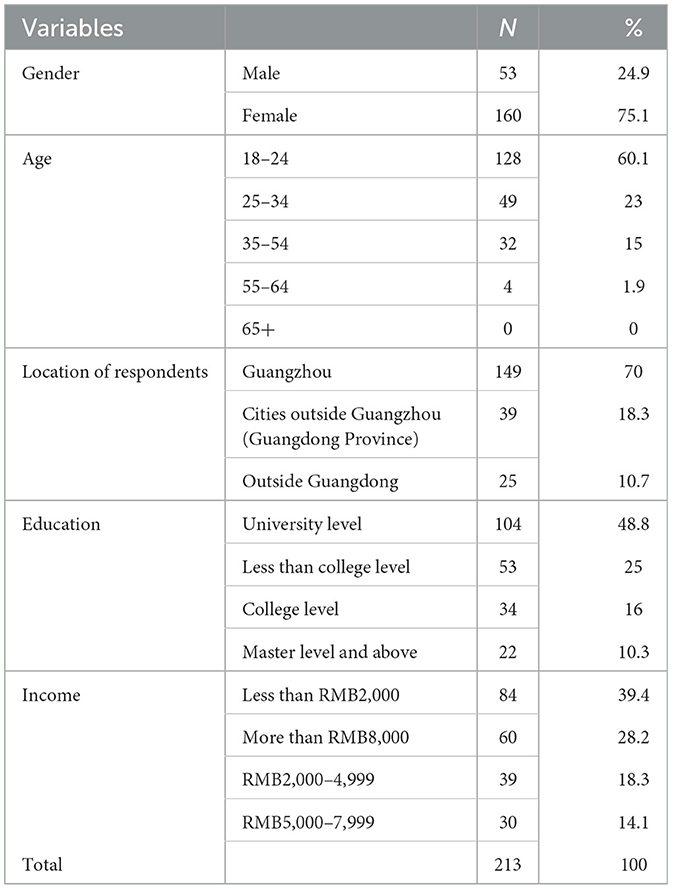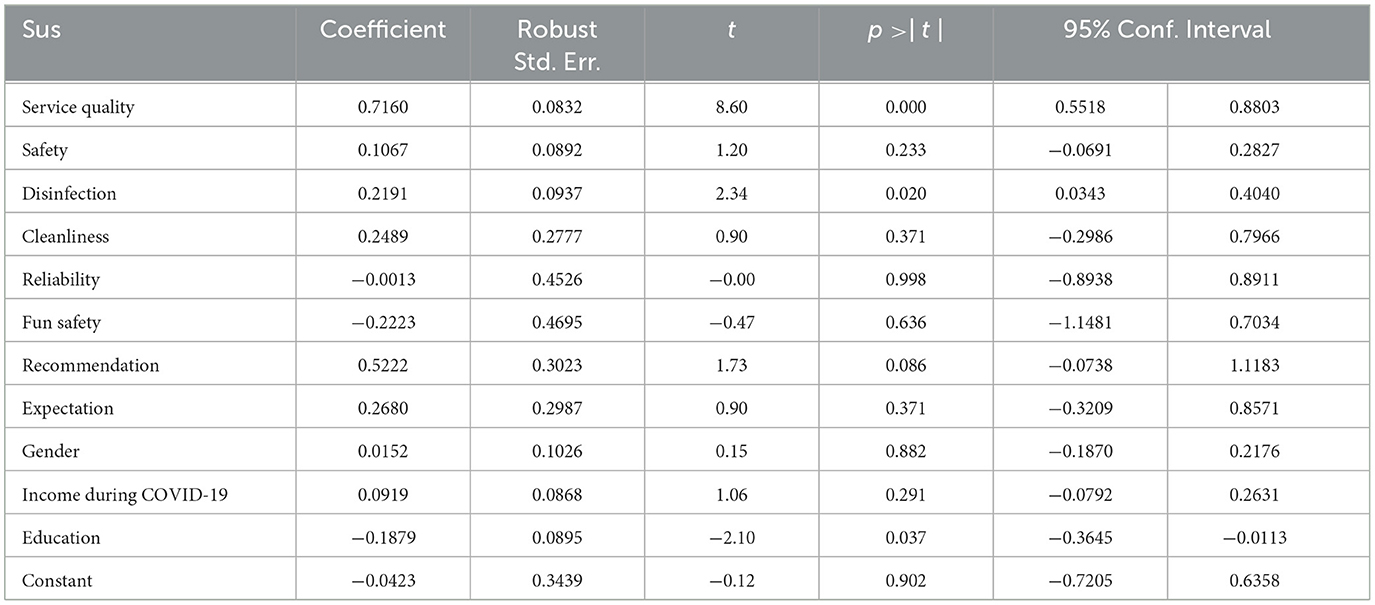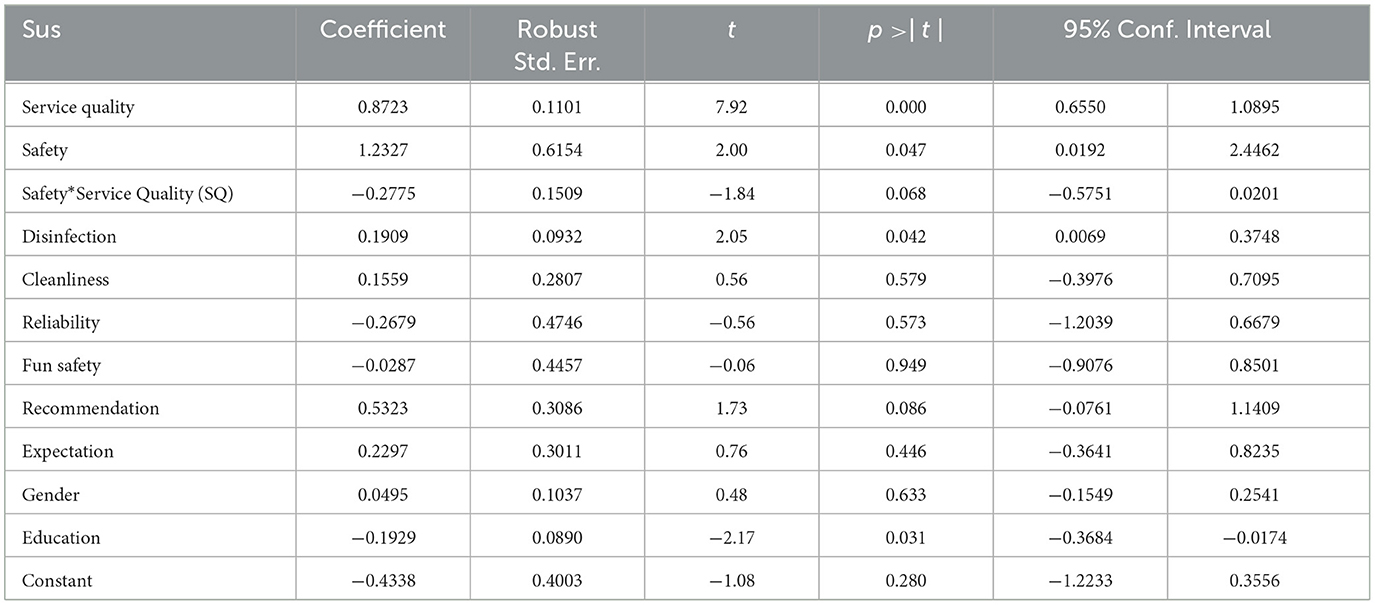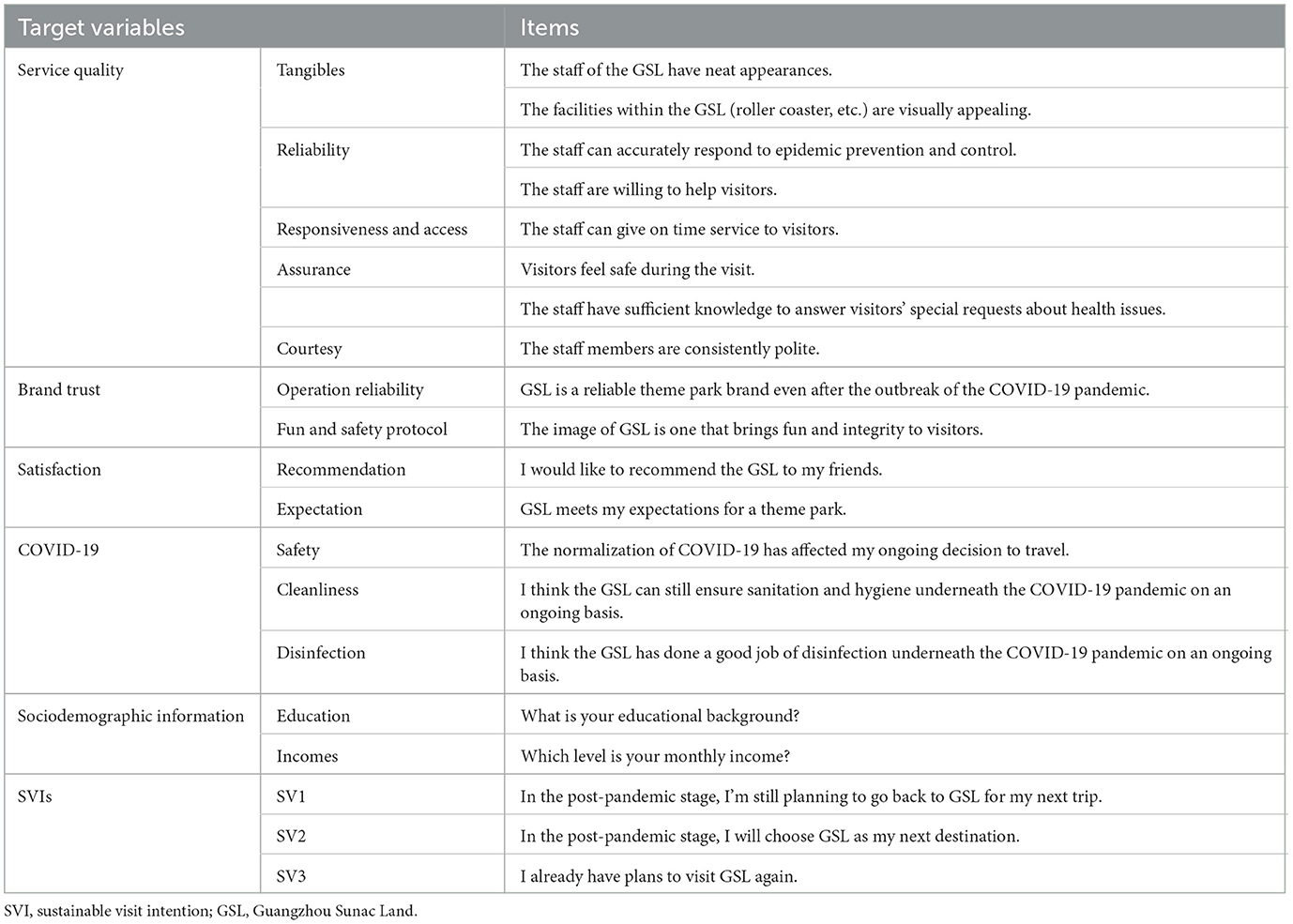- School of Management, Guangdong Peizheng College, Guangzhou, China
Theme parks, as indispensable commodities within the tourism industry, wield significant influence in fostering local and national economic development. However, despite their crucial role, there remains a dearth of comprehensive research concerning the determinants of theme park visits. Employing the THEMEQUAL scale, this study uses an ordered logit model and an in-depth interview method to investigate the effects of service quality on visitors' sustainable visit intentions (SVIs). The results show that service quality is the most pivotal determinant shaping SVIs and that the effects are moderated by COVID-19, i.e., a reduced emphasis on service quality in bolstering visitors' sustainable visit inclinations during this pandemic. In particular, the staff delivering assurances and being courteous markedly influence visitors' perceptions. This research contributes to a comprehensive interplay between service quality, COVID-19, and visitors' SVIs, providing references for policymakers and managers to develop theme park recovery policies in the post-pandemic era.
1 Introduction
Due to an overflow of operators, the theme park industry has become growingly competitive; traditional strategies, such as adjusting admission prices and increasing attractions, are acknowledged as effective methods to attract tourists (Fotiadis and Vassiliadis, 2016). Increasingly, recent studies have emphasized the role of service quality (Hussain et al., 2023), especially in the post-pandemic era. Data provided by the International Association of Amusement Parks and Attractions (IAAPA) reveal a stark reality: among the top 25 theme parks globally, only approximately 178.5 million visits were recorded in 2022, a striking decline of 75% compared to the pre-pandemic figures of 2019.
The substantial global decline in attraction attendance in 2020 had far-reaching repercussions, resulting in considerable job and economic losses (Blomqvist et al., 2023) and posing potential risks of social instability. Notably, China experienced a particularly noteworthy downturn (Lee et al., 2024). The “Evaluation of Chinese Theme Park Competitiveness” report in 2021 revealed a staggering 50.43% decline in visitor numbers, coupled with a revenue decrease of 49.87% in the same year. Hence, it is imperative to conduct research on the theme park industry. Numerous factors influence the development of theme parks, including pricing, destination attractions, and their distinctive offerings. However, among these factors, visitors place paramount importance on service quality. Consequently, theme park management should prioritize enhancing service quality over other elements. Considering the importance of service quality in attracting tourists and its depth and breadth of service quality content, it is necessary to identify which aspects of service quality can more effectively lure visitors and thus provide references for decision-makers when devising and executing strategic measures to ensure the industry's sustainable development.
While previous research has discussed the influence of service quality on theme park development, there remains a significant gap in the literature that is yet to be addressed. Traditionally, researchers adopt the SERVQUAL scale as a reliable measure of service quality in the hospitality, transportation, and banking sectors (McDougall and Levesque, 2000; Most et al., 2023; Przybytniowski, 2023). However, Tsang et al. (2012) highlighted that the SERVQUAL scale includes some methodological flaws (Babakus and Boller, 1992). Furthermore, to enhance the validity and reliability of this scale, they modified SERVQUAL by incorporating the Courtesy dimension and named it THEMEQUAL. The new scale is more suitable for gauging service quality specifically within theme parks, and it has been used to evaluate theme parks in Sri Lanka (Liyanage and Wickramarathne, 2019), Croatia (Valcic et al., 2015), Taiwan (Fotiadis, 2016; Fotiadis and Vassiliadis, 2016). It is unfortunate to note that studies on the service quality of theme parks in China measured using the THEMEQUAL scale remain notably limited. Given that Chinese visitors are deeply influenced by traditional Chinese culture and values, they place a great emphasis on the perception of courtesy from others. Therefore, the Courtesy dimension plays a pivotal role in the China market (Tsang et al., 2012). Furthermore, prior research has corroborated that Chinese visitors prioritize the friendliness and politeness of employees (Hussain et al., 2023). Hence, using the new scale, THEMEQUAL, is more appropriate for researching Chinese theme parks and their visitors.
Research has sparsely examined the relationship between service quality and sustainable visit intentions (SVIs) in China's theme parks. Given that China has many theme parks, a comprehensive understanding of how service quality influences SVIs is necessary. This study aims to explore how service quality affects SVIs by adopting a more comprehensive service quality evaluation indicator and the moderating effect of COVID-19. We further explore which specific aspects of service quality have a more significant effect on visitors' SVIs.
The contributions of this article lie, first, in employing a comprehensive service quality measurement; by doing this, we fill the gap in research on the impact of service quality on theme parks in China. The initial application of the THEMEQUAL scale in research on the theme parks market in China marks a significant step forward. This pioneering effort promises to provide a more accurate and robust measurement of service quality within the Chinese theme park market in the future. Second, we further identify which specific aspects of service quality are more important for attracting visitors. Chinese visitors exhibit unique preferences and demands regarding theme park service quality compared to visitors from other nationalities (Tsang et al., 2015). Consequently, there is a need for research that delves into specific individual measurements to fully understand these distinct requirements. Third, we introduce a new factor-recommendation, broadening the scope of defining visitors' sustainable intention. It confirmed that visitors' SVIs require a unique measurement approach (Bothe et al., 2016).
This factor signifies visitors' likelihood to recommend the theme park to others, reflecting potential SVIs. Our findings can enhance the comprehension of the relationship between service quality and visitors' revisit intention, which may benefit theme park operators by informing them of strategies for enhancing visitor satisfaction and providing references for local government agencies by augmenting their oversight and support for the theme park industry.
The remaining sections are structured as follows. Section 2 provides a literature review that explores the relationship between service quality and SVIs. After highlighting the existing research gaps, we introduce the conceptual framework. Section 3 offers a detailed overview of the data collection, covering survey procedures, research instruments, and the overall methodological approach. Section 4 presents the research results and findings. Finally, Section 5 provides managerial insights, discusses the limitations of the research, and presents our concluding thoughts.
2 Literature review and research framework development
In the theme park industry, much of the prior research has predominantly focused on revisit intentions rather than SVIs. Despite their interconnectedness, these concepts differ inherently. SVIs are defined as a consistent inclination to visit a destination (Seong et al., 2021). This concept expands beyond mere revisitation and encompasses visitors' inclination to recommend the destination to others (Seong et al., 2021). It also encompasses uncertain elements, such as trip cancellations or changes in planned destinations. However, there is a noticeable dearth of research dedicated explicitly to the conceptualization of SVIs in existing studies. Additionally, the nuanced variables associated with SVIs have seldom been explored.
Conversely, revisit intention has been characterized as an indicator of visitors' actual propensity to return to a destination (Baker and Crompton, 2000; Stylos et al., 2017; Wu et al., 2018). It is often described as the likelihood of a visitor returning within a year (Lai and Kuo, 2010; Prayogo and Kusumawardhani, 2016) or their behavioral inclination to revisit in the foreseeable future (Acharya et al., 2023).
Existing literature highlights an urgent and pressing need to comprehensively explore the variables associated with SVIs in future research endeavors. Regardless of their controllability, these pivotal variables need to be considered, analyzed, and quantified. A nuanced understanding will aid theme park managements in making informed decisions that aim to bolster the levels of visitors' SVIs.
2.1 Influential factors for SVIs
SVIs have been confirmed as a way of continuous visit intention (Seong et al., 2021). Abdulrazak and Quoquab (2018) have noted that sustainable consumption intentions or behaviors, articulated in various forms, have garnered considerable attention in academic literature. In understanding visitors' future behaviors and intentions, numerous studies have posited that visitors' perceptions of destination image, value, and satisfaction influence both revisit and recommendation intentions (Quintal and Polczynski, 2010; Phillips et al., 2013; Stylos et al., 2016). In the realm of tourism studies, Pai et al. (2020) proposed a research model to elucidate the relationship between tourists' experience satisfaction, their happiness, and their revisit intention. Additionally, Wu et al. (2018) discerned the pivotal roles played by experiential satisfaction and theme park image in determining revisit intentions in the theme park industry. To precisely delineate SVIs, this study encompasses various facets of consumption, with special attention paid to their social and environmental ramifications.
Previous research has highlighted specific demographic characteristics as pivotal variables in assessing SVIs. Characteristics such as income, education, and gender have been meticulously examined to highlight the influence of sociodemographic factors on SVIs (Um et al., 2006; Kusumawati et al., 2019; Seong et al., 2021; Acharya et al., 2023). Other determinants such as service quality have also been highlighted, with Mohaidin et al. (2017) affirming its paramount role in shaping SVIs.
Satisfaction stands as a pivotal factor influencing visitors' intentions for future visits and has been recognized as a precursor to sustainable intentions (Chen and Tsai, 2007). A “quality-satisfaction-behavioral intention” paradigm was formulated to study the intricacies of tourist consumption. Uzir et al. (2021) also identified a nuanced connection between trust and repurchase intention. The perception of price, encompassing both monetary and behavioral costs, has been investigated and confirmed to significantly influence visitors' revisit intentions (Liu and Lee, 2016). Additionally, the role of public health events in shaping SVIs has been explored to enhance theme park management strategies and sustain competitiveness in a post-pandemic world. Both Esposti et al. (2021) and Seong et al. (2021) determined that perceived risks associated with public health events profoundly impact visitors' attitudes and behaviors. Consequently, there is a compelling call for both empirical and theoretical research focused on SVIs within the theme park industry.
2.2 Service quality impacts on SVIs
Previous research has suggested that service quality is a determinant of tourists' SVIs (Nilplub et al., 2016; Kanwel et al., 2019). For instance, Quintal and Polczynski (2010) incorporated factors such as activity, health, safety, and cleanliness, emphasizing their relation to perceived service quality. In addition, service quality has been confirmed by different scholars as having a positive influence on visitors' revisit intention and satisfaction (Bigné et al., 2001; Hwang et al., 2005; Nugroho et al., 2021; Velmurugan et al., 2021). In terms of the theme park–related context, Hapsari et al. (2021) and Wen et al. (2020) suggested that, especially in a post-pandemic scenario, tourists might prioritize specific aspects of perceived service quality, focusing on health safety measures such as cleanliness and adherence to social distancing guidelines. These health-centric measures could substantially influence tourists' propensity for repeat visits and their trust in the brand (Saleem et al., 2017; Nhamo et al., 2020; Prentice et al., 2021; Seong et al., 2021).
Wen et al. (2020) and (2021) suggested that, especially in a post-pandemic scenario, tourists might prioritize specific aspects of perceived service quality, focusing on health safety measures such as cleanliness and adherence to social distancing guidelines.
The SERVQUAL scale has been a key metric used by researchers to assess service quality. Additionally, Liu and Lee (2016) confirmed that service quality could be characterized by the five dimensions of the SERVQUAL scale. Kao et al. (2008) also stated the impact of service quality on visitor visit intentions, including loyalty to theme parks. The THEMEQUAL scale was introduced by Tsang et al. (2012) to evaluate the service quality at Hong Kong Disneyland theme park; it includes six dimensions—tangibles, reliability, responsiveness and access, assurance, empathy, and courtesy—that influence visitor satisfaction. Subsequent studies have showed that (Tsang et al., 2012; Fotiadis, 2016; Fotiadis and Vassiliadis, 2016; Wu et al., 2018; Xie and Luo, 2021): (1) tangibles, evaluated through the neat appearance of staff and the presentation of facilities; (2) reliability, assessed by the staff's willingness and capability to resolve visitor issues; (3) responsiveness and access, gauged by the staff's timely response to visitor requests; (4) assurance, measured by visitors' perception of facility safety within the theme park; (5) empathy, updated to gauge whether staff understand visitors' specific sanitary needs; and (6) courtesy, determined by the consistent politeness exhibited by staff members.
2.3 Gaps and research framework
Several gaps in the extant research have been identified, and our study offers some contributions to expand the literature related to theme parks. First, while the SERVQUAL scale has predominantly been used as the measurement tool, there remains a paucity of studies applying the THEMEQUAL scale to theme parks in China. According to Tsang et al. (2012), SERVQUAL is not entirely suitable for research on theme parks, especially in China's theme parks market. In addition, the Courtesy dimension is deemed indispensable for Chinese visitors. Second, previous research has inadequately explored the concept and connotation of SVIs. Notably, when visitors express an intention to recommend the destination to others, they inherently manifest an inclination toward sustainable visitation. Although previous researchers have touched on the concept of SVIs, their focus has predominantly been on national parks and general tourism markets (Rodger et al., 2015). Notably, the theme park industry remains largely unexplored in this regard. Third, while the pandemic has garnered considerable attention and has been established as an influence on visitor perceptions in tourism studies, there exists a scarcity of studies dedicated to exploring how the pandemic moderates the relationship between visitors' perceived service quality and their SVIs. However, these current research efforts have not been highly affirmed, and the discussion on this aspect is far from enough at present.
Considering the existing research, we design the following research framework (Figure 1).
In the context of theme parks, service quality is determined by how well a service aligns with visitors' expectations and addresses their needs. Scholars suggest that these expectations are shaped by factors outlined in the THEMEQUAL model—tangibles, reliability, responsiveness and access, assurance, empathy, and courtesy (Tsang et al., 2012)—and by satisfaction levels (Choi and Kim, 2000). The visitors' sustainable intentions pivot on their perceptions of experience quality, which encompasses both the perceived service quality and the satisfaction derived from previous interactions. As noted, visitors' perceptions of satisfaction concerning tourism products are rooted in expectations (Bernini et al., 2015). The likelihood of visitors making recommendations can be attributed to their satisfaction with previous visits (Bigne et al., 2005). Consequently, it stands to reason that evaluations of service quality and satisfaction by visitors will significantly shape their SVIs.
The paramount significance of brand trust within the theme park industry has been well established (Crosby et al., 1990; Jin et al., 2013). Brand trust is believed to wield a direct influence on customer behavioral loyalty. In the domain of theme park research, superior service quality contributes significantly to visitors' trust in a specific destination. Consequently, the enhancement of visitors' brand trust in theme parks has become increasingly imperative (Xie and Luo, 2021; Su et al., 2022). When visitors find satisfaction in their travel experiences, they tend to place their trust in the service provider, fostering a predisposition to revisit the same brand (Kusumawati et al., 2019). This study suggests that visitors' perceptions of operational reliability, coupled with safety and entertainment protocols, serve as crucial indicators for brand trust levels, especially in the post-pandemic landscape. Additionally, given the transformative impact of the COVID-19 outbreak on travel patterns, the focus on health safety management (Esposti et al., 2021) and sanitation measures (Wei et al., 2021) becomes crucial in researching visitors' SVIs.
3 Methodology
3.1 Study area
The study area is Guangzhou Sunac Land (GSL), a notable amusement park located in Guangzhou, a central city within the Guangdong–Hong Kong–Macao Greater Bay Area. GSL offers an array of attractions including a unique dual-track roller coaster, a flying theater, and advanced “4K+Virtual Reality (VR)” entertainment options showcasing cutting-edge amusement technology. Compared to other theme parks in the region, its distinctive theme centered on snow and ice, catering to visitors with a preference for snow and ice experiences, which is particularly appealing in the subtropical zone of China, stands out. Despite its initial allure, GSL experienced a decline in attention following the outbreak of COVID-19. Thus, we chose this as our study area.
3.2 Questionnaire design and data collection approach
3.2.1 Questionnaire design
The questionnaire, structured around the conceptual framework, encompasses five latent variables: (1) service quality, which, based on the THEMEQUAL scale designed by Tsang et al. (2012), includes tangibles, reliability, responsiveness and access, assurance, empathy, and courtesy; (2) the impact of COVID-19, which is investigated by the health safety dimension (Wirawan et al., 2021) and the cleanliness and disinfection dimension (Milman et al., 2020; Zhu et al., 2022); (3) satisfaction, which is assessed via visitors' expectations (Quintal and Polczynski, 2010; Stylos et al., 2016) and their intentions for recommendation (Phillips et al., 2013); (4) brand trust, which is reflected in the operational reliability and the fun and safety protocols, as indicated in the study by Liu and Lee (2016); and (5) sociodemographic information, which considers that visitors with different demographics or psychographics usually have various purposes for visiting theme parks (Kao et al., 2008).
Drawing on an extensive review of existing literature (Tsang et al., 2012; Valcic et al., 2015), the questionnaire comprised 28 items representing those latent variables, with each item having responses anchored on a 5-point Likert scale. A pretest was conducted before the data collection so as to guarantee the reliability and validity of the questionnaire. We consulted university professors, scholars in the tourism industry, service firm managers, and theme park management. After professionals confirmed the items' reliability and validity, a preliminary test was conducted at the main gate of GSL from 20 May to 25 May, generating 50 questionnaires, to examine the survey's efficacy. Based on the feedback from this preliminary phase, adjustments were made to enhance the clarity and effectiveness of the questionnaire. Eventually, the questionnaire included 28 items (see the Appendix) and was confirmed for testing the target variables.
3.2.2 Data collection
Over the three weekends in June 2023, eight trained research assistants were stationed at the main park exit, strategically chosen as the area with the highest visitor concentration based on preliminary observations. Incentive gifts were offered to encourage survey participation. The busiest visiting hours, observed during the preliminary test, were between 12 p.m. and 6 p.m. In addition, GSL was expecting approximately 20,000 visitors per day. Due to an insufficient number of research assistants, approximately 1.25% of the visitors per day were investigated as respondents.
Approximately 250 tourists who had visited GSL were approached to complete the survey. Respondents had to be 18 years of age or older and willing to participate voluntarily. The research employed a systematic random sampling, with each assistant approaching every 100th potential respondent to ensure comprehensive coverage.
From the survey, we obtained 213 valid questionnaires, representing a response rate of 85.2%. To evaluate internal consistency, we employed both Cronbach's alpha and the Kaiser–Meyer–Olkin (KMO) test. Significant correlations among the initial variables were essential, with the KMO coefficient being a minimum of 0.8. Furthermore, to ascertain the reliability and validity of the scale, Cronbach's alpha values were required to range between 0.80 and 0.90. Descriptive statistics for each variable are presented in Table 1.
3.3 Logit model method
The responses from respondents were divided into five types based on the degrees of perception. Therefore, to identify the factors influencing visitors' SVIs, we employed the ordered logit regression model using Stata 17.0. The ordered logistic model, as delineated by Cameron and Trivedi (2005), is specified as follows:
where the dependent variable Yi is the dependent variable reflecting the 5 degrees of recognition on the SVIs. The value range of Yi is from 1 to 5, representing Strongly Disagree, Disagree, Neutral, Agree, and Strongly Agree, respectively. The corresponding question to SVIs included three questions referring whether visitors would choose GSL as their next destination or already had a plan to visit the GSL in the future (SVI). We obtained the SVIs by taking the mean value of answers for the following three statements: (1) In the post-pandemic stage, visitors still planning to go back to GSL for my next trip. (2) In the post-pandemic stage, visitors will choose GSL as their next destination. (3) Visitors already have plans to visit GSL again. The independent variables encompass continuous variables (e.g., service quality) and categorical variables (e.g., COVID-19, brand trust, satisfaction, and sociodemographic information). Among them, service quality is our core variable. To mitigate poor controls, other controlling variables were bifurcated into two levels: “Strongly Agree” and “Disagree” were coded as 0, and “Neutral,” “Agree,” and “Strongly Disagree” were coded as 1.
3.4 In-depth interviews
In the research on regression model methods, a limitation has been noted about exploring service quality and SVIs. This study needs to dig out the most important factor of service quality effects on SVIs. To gain a more comprehensive understanding of respondents' perspectives, visiting experiences, attitudes, and the motivations behind SVIs, approximately 20 theme park visitors were randomly selected for in-depth interviews. These interviews covered various service quality variables and visitors' SVIs toward GSL. In this study, research is going to determine the underlying components that influence Chinese theme park visitors' SVIs, such as service quality, brand trust, and satisfaction. Respondents were asked some related questions after they filled out the questionnaires by 5 degrees (1-Stongly Disagree; 2-Disagree; 3-Slightly Agree; 4-Agree; 5-Strongly Agree). For example, they were asked about which part of service quality was most concerning to them or which part of sanitizing work was the most important.
4 Results
4.1 Sociodemographic profile of the respondents
Among all respondents, 24.9% (53 respondents) were male, while 75.1% (160 respondents) were female (Table 2), indicating a higher attraction of female visitors to the theme park. The most prevalent age bracket among visitors was the 18–24 age group, accounting for 60.1% of the total respondents. This demographic inclination could be attributed to the park's appeal to a younger audience, with its focus on winter sports and roller coasters. Of the participants, 48.8% were university students or graduates, and 31% were college students or had completed their college education. The majority of respondents were university students or younger, likely due to the survey being conducted during the summer break.
A substantial 71.2% of respondents hailed from Guangzhou, the city where GSL is situated. Another 17.6% came from other parts of Guangdong Province. The data suggest that those residing farther away might be dissuaded by the distance. In terms of monthly income, 40.1% reported earning < RMB 2,000 (approximately US $290), while 27.6% indicated earning over RMB 8,000 (roughly US $1,170).
Our questionnaire results indicate that GSL attracts more females, younger individuals, residents from nearby regions, college students, and individuals from lower-income groups.
4.2 The comprehensive effect of service quality effects on SVI
A positive correlation exists between service quality and SVI, as evidenced in Table 3. Superior service quality, as gauged by the THEMEQUAL scale including tangibles, reliability, responsiveness and access, assurance, empathy, and courtesy, aims to deliver an exemplary visitor experience. This scale ensures attributes such as employee friendliness, professionalism, and efficient problem-solving capabilities. While we applied some similar variables included in the SERVQUAL scale, our study stands out because it integrates (Tsang et al., 2012) inclusion of a new factor—courtesy, which has been deemed influential in shaping service quality within the theme park industry. These factors augment visitors' perceived experiences and subsequently reinforce their SVIs. In addition, top-tier facilities, such as premium accommodations, gourmet dining, and other associated travel amenities, further cultivate SVIs among guests. The coefficient of service quality is approximately 0.716, which is higher than other control variables, meaning that service quality is a paramount determinant that steers the expectation-confirmation paradigm in visitor SVI. According to Ueno (2009), in-depth interviews serve as a valuable qualitative investigation tool, facilitating the exploration of research outcomes through face-to-face discussions about specific topics. The purpose of conducting in-depth interviews was to capture respondents' feelings and thoughts using words instead of numbers. This approach aimed to gain a deeper understanding of relevant issues from the respondents' cognitive framework. The in-depth interviews showed that visitors anticipate prompt and reliable responses from service personnel. The staff's competency in addressing concerns, coupled with their attentive demeanor, influences visitors' perceptions of the theme park.
Among the control variables, we find that disinfection, recommendations, and education have effects on the SVIs. It is imperative for theme park management to prioritize epidemic prevention measures and invest considerably in ensuring cleanliness and health standards. Titu et al. (2016) further corroborate the notion that tourism sustainability is primarily underpinned by superior quality services. Moreover, visitors' visiting experiences and perceptions of SVIs are influenced by recommendation (Wang et al., 2020). Visitors are willing to choose destinations recommended by their peers because recommendations based on actual visits or firsthand experiences are authentic and credible (Taheri et al., 2021). Conversely, the education variable displays a notable albeit negative correlation. Respondents with higher educational backgrounds might prioritize their professional commitments over recurrent visits to GSL. Additionally, highly educated visitors often exhibit a propensity for variety-seeking. They might lean toward exploring other cultural destinations rather than repeatedly visiting theme parks.
The role of service quality in affecting visitors' SVIs may have been weakened by COVID-19. First, health and safety became the foremost priority for visitors during the outbreak (Lai et al., 2023). Even if a destination significantly enhances its service quality, insufficient epidemic prevention measures might prompt visitors to reconsider their plans. Second, the economic downturn during the pandemic resulted in job losses and reduced incomes for many individuals. Despite potential service quality improvements in the post-pandemic era, these individuals may opt to save money by staying home or choosing more affordable destinations rather than revisiting the same theme parks. The regression results with interaction terms in Table 4 are consistent with findings by Cambefort (2020), Jones and Comfort (2020), and Rasoolimanesh et al. (2021), indicating that the COVID-19 pandemic can alter tourists' intentions and behaviors, surpassing the influence of service quality changes on travel patterns.
Insights from in-depth interviews also revealed that there may be a shift in visitor priorities away from service quality. According to respondent A, although he admitted the importance of service quality, a reduced income due to the COVID-19 pandemic also affected his SVIs. Respondent B emphasized prioritizing cleanliness and disinfection management over service quality, as COVID-19 was still impacting his daily life.
4.3 The specific effects of services on SVI
We further examine the effects of services on sustainable development and discern that two variables exert a notably significant influence on visitors' SVIs (refer to Tables 5, 6). Visitors place greater emphasis on the “assurance” and “courtesy” variables when considering SVIs.
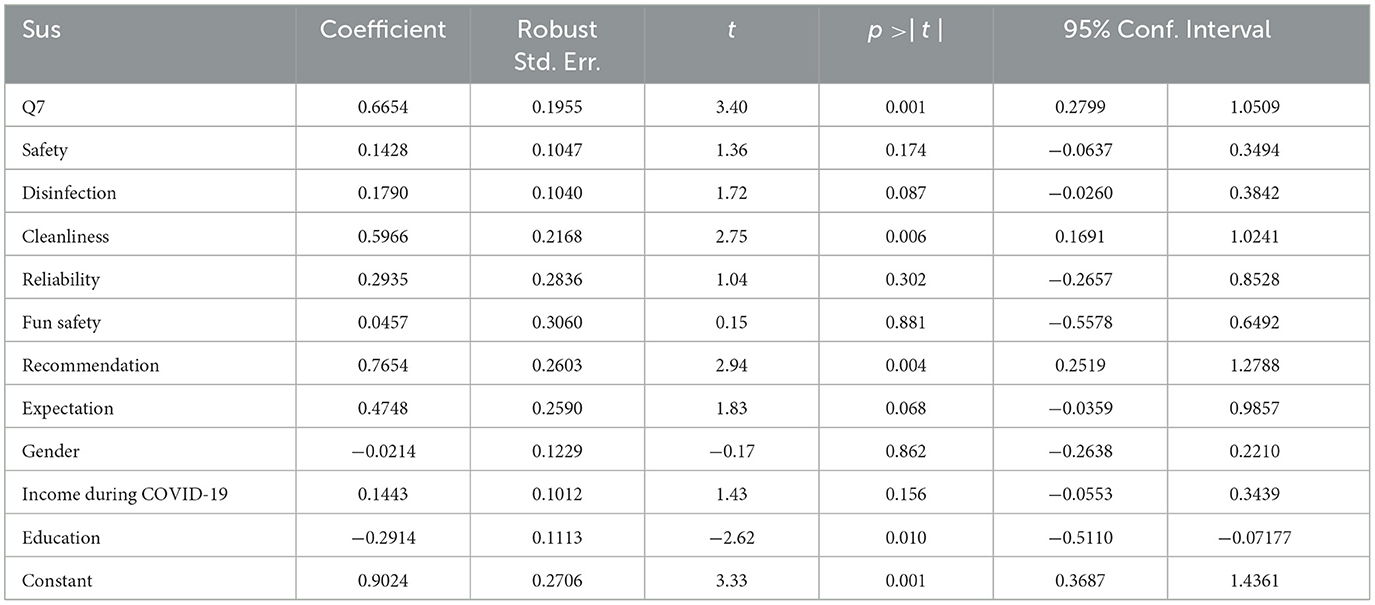
Table 5. Ordered logit estimates for different variables of service quality factor (q7) effects on SVI.
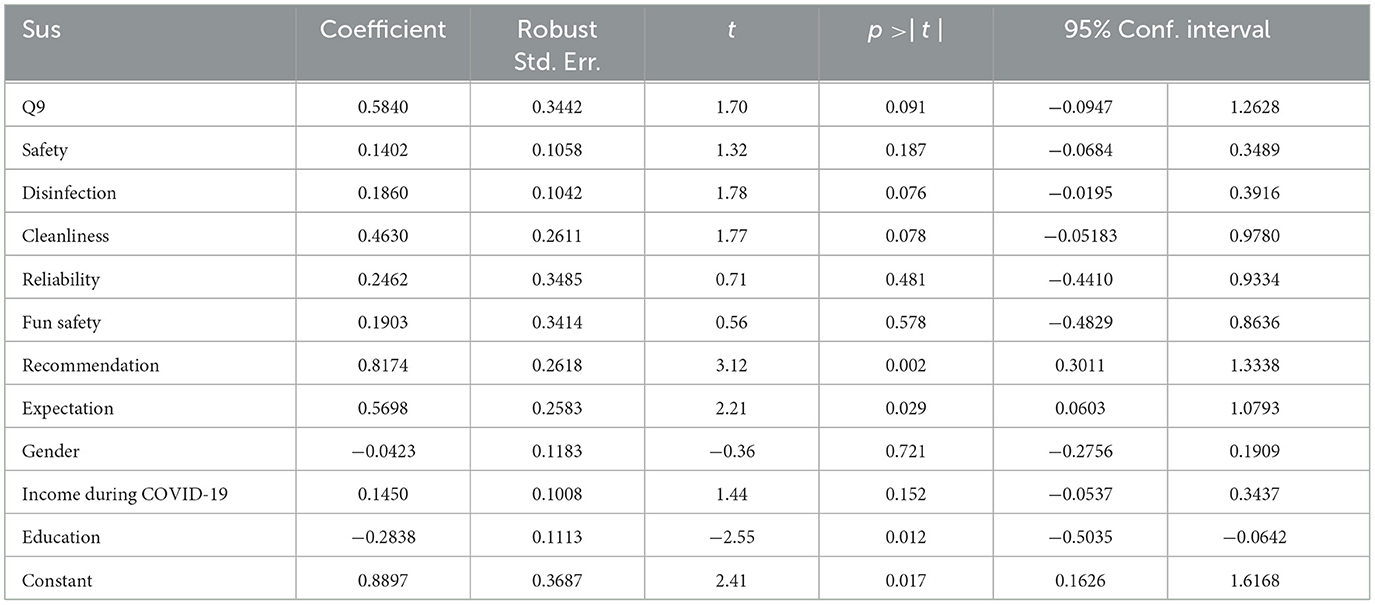
Table 6. Ordered logit estimates for different variables of service quality factor (q9) effects on SVI.
The Assurance indicator is predicated on the knowledge acquired by employees and their capacity to instill trust and confidence (Tsang et al., 2012). Visitors' sustainable intentions are influenced by employees' capacity to instill confidence, address inquiries with adequate knowledge, and ensure visitors' sense of security. Staff responses give visitors a feeling of respect and attention, thus enhancing their satisfaction and SVIs. Consequently, higher service quality will be delivered by minimizing the gap between the expectations and perceptions of visitors of staff performance. Additionally, the “courtesy” of employees emerged as a significant dimension, characterized by the affable and polite demeanor of employees, which can offer a gratifying experience to visitors (Wu et al., 2018). Visitors seek relaxation and security at the theme park; a reliable and safe experience makes the service worthwhile.
5 Conclusion
Service quality has long been considered a vital factor influencing visitors' SVIs. However, the onset of the pandemic has altered visitors' travel behaviors, complicating the relationship between service quality and SVIs. Some visitors now prioritize aspects of service quality, such as public hygiene management due to pandemic concerns. For instance, during the pandemic's peak, travelers were notably focused on scrutinizing destinations' cancellation and refund policies (Neuburger and Egger, 2021; Zha et al., 2022). As the perceived threat of COVID-19 diminishes among tourists, there is a resurgence in emphasis on service quality at tourist destinations (Tian et al., 2020; Li et al., 2022; Lu et al., 2022). However, others may devalue service quality in favor of indulgent spending in the post-pandemic era.
This study employs the comprehensive framework THEMEQUAL and an ordered logit model to evaluate the effect of service quality on SVI and identifies specific aspects of service quality that play a more important role. The incorporation of the Courtesy dimension into THEMEQUAL is highly fitting for capturing Chinese visitors' expectations regarding service quality. This addition resonates well with the influence of traditional Chinese culture and values, which place significant emphasis on courteous behavior and interactions. Our findings show that service quality can significantly increase visitors' SVIs and surpass the role of other determinates, such as education, recommendations, and disinfection dimensions. However, the pandemic has diminished this effect. Among them, the Assurance and Courtesy dimensions, which have been constructed as staff conveying knowledge and confidence to visitors, are overshadowed by other variables. In addition, health safety, such as disinfection, and satisfaction through recommendations are also important aspects affecting SVI.
Theoretically, this study contributes to the expansion of service quality research within the theme park industry by applying a unique framework. It enriches the existing framework for measuring service quality, thereby providing a foundation for future studies. From a practical standpoint, the outcomes of the proposed framework offer actionable insights for theme parks to enhance their service quality by addressing visitors' concerns. Additionally, it highlights the importance of tailoring measurement approaches to specific circumstances, emphasizing the need for individualized assessments. Moreover, there is a practical significance for future research on theme park service quality, as the findings can inform local government's efforts to support the development of local theme parks based on measurement results. This study provides a comprehensive measurement of visitors' future intentions, offering implications for park managers and policymakers. Contrary to prior studies (e.g., Xie and Luo, 2021) emphasizing uniqueness as being pivotal in theme park assessment, our research highlights that service quality, especially staff politeness, combined with their knowledge and ability to instill trust are the most important factors for attracting tourists. Therefore, enhancing both dimensions is recommended, with a focus on improving facility quality and staff courtesy through training. Additionally, health safety measures and recommendations play pivotal roles. Reinforcing disinfection levels for public hygiene and introducing recommendation policies can strengthen visitors' recommendations.
This study also has limitations. The exclusive focus on GSL may limit capturing the full spectrum of theme parks in China. Subsequent studies should consider diverse parks, including foreign-funded or privately operated parks. Furthermore, the research's temporal constraints might have skewed the representativeness of our findings. Conducted over a few weekends in June, our survey predominantly captured family groups and individuals in their 20s. Extending the research timeframe, spanning peak and off-peak seasons, and seeking a more representative cohort could yield more comprehensive insights. Finally, exploring the disparity between intent and action in a post-pandemic context regarding preventive measures, such as sanitization, remains an area for further investigation.
Data availability statement
The original contributions presented in the study are included in the article/supplementary material, further inquiries can be directed to the corresponding author.
Ethics statement
Ethical review and approval was not required for the study on human participants in accordance with the local legislation and institutional requirements. Written informed consent from the patients/participants or patients/participants legal guardian/next of kin was not required to participate in this study in accordance with the national legislation and the institutional requirements.
Author contributions
JL: Writing—original draft, Writing—review & editing. XL: Writing—original draft.
Funding
The author(s) declare financial support was received for the research, authorship, and/or publication of this article. This research was funded by the Education Department of Guangdong Province (No. 2019GWQNCX167).
Conflict of interest
The authors declare that the research was conducted in the absence of any commercial or financial relationships that could be construed as a potential conflict of interest.
Publisher's note
All claims expressed in this article are solely those of the authors and do not necessarily represent those of their affiliated organizations, or those of the publisher, the editors and the reviewers. Any product that may be evaluated in this article, or claim that may be made by its manufacturer, is not guaranteed or endorsed by the publisher.
References
Abdulrazak, S., and Quoquab, F. (2018). Exploring consumers' motivations for sustainable consumption: a self-deterministic approach. J. Int. Consum. Market. 30, 14–28. doi: 10.1080/08961530.2017.1354350
Acharya, S., Mekker, M., and Vos, J. D. (2023). Linking travel behavior and tourism literature: Investigating the impacts of travel satisfaction on destination satisfaction and revisit intention. J. Transport. Res. Interdisc. Perspect. 17:100745. doi: 10.1016/j.trip.2022.100745
Babakus, E., and Boller, G. W. (1992). An empirical assessment of the SERVQUAL scale. J. Bus. Res. 24, 253–268. doi: 10.1016/0148-2963(92)90022-4
Baker, D. A., and Crompton, J. L. (2000). Quality, satisfaction and behavioral intentions. Ann. Tour. Res. 27, 785–804. doi: 10.1016/S0160-7383(99)00108-5
Bernini, C., Urbinati, E., and Vici, L. (2015). Visitor expectations and perceptions of sustainability in a mass tourism destination. J. Tour. South. Eastern Eur. 3, 1–17.
Bigne, J. E., Andreu, L., and Gnoth, J. (2005). The theme park experience: an analysis of pleasure, arousal and satisfaction. Tour. Manag. 26, 833–844. doi: 10.1016/j.tourman.2004.05.006
Bigné, J. E., Sánchez, M. I., and Sánchez, J. (2001). Tourism image, evaluation variables and after modellin behaviour: Inter-relationship. Tour. Manag. 22, 607–616. doi: 10.1016/S0261-5177(01)00035-8
Blomqvist, S., Hognas, R. S., Virtanen, M., LaMontagne, A. D., and Hanson, L. L. M. (2023). Job loss and job instability during the COVID-19 pandemic and the risk of depression and anxiety among Swedish employees. J. Popul. Health 22:101424. doi: 10.1016/j.ssmph.2023.101424
Bothe, S., Schaffner, D., Juttner, U., and Schlange, L. (2016). Sustainable service quality. Sustain. Manag. For. 24(4), 353–359. doi: 10.1007/s00550-016-0422-7
Cambefort, M. (2020). How the COVID-19 pandemic is challenging consumption. Mark. Globaliz. Dev. Rev. 5:2. doi: 10.23860/MGDR-2020-05-01-02
Cameron, A. C., and Trivedi, P. K. (2005). Microeconometrics: Methods and Applications. Cambridge: Cambridge University Press. doi: 10.1017/CBO9780511811241
Chen, C.-F., and Tsai, D. (2007). How destination image and evaluative factors affect behavioral intentions? Tour. Manage. 28, 1115–1122. doi: 10.1016/j.tourman.2006.07.007
Choi, N., and Kim, Y. (2000). The effects of justice factors and needs for cognitions on the consumer-satisfaction in company-complaint-handling. J. Daehan Assoc. Bus. Admin. 24.
Crosby, L. A., Kenneth, R. E., and Deborah, C. (1990). Relationship quality in services selling: an interpersonal influence perspective. J. Market. 54, 68–81. doi: 10.1177/002224299005400306
Esposti, P. D., Mortara, A., and Roberti, G. (2021). Sharing and sustainable consumption in the era of COVID-19. Sustainability 13:1903. doi: 10.3390/su13041903
Fotiadis, A. K. (2016). Modifying and applying time and cost blocks: the case of E-Da theme park, Kaohsiung, Taiwan. Tour. Manag. 54, 34–42. doi: 10.1016/j.tourman.2015.10.013
Fotiadis, A. K., and Vassiliadis, C. A. (2016). Service quality at theme parks. J. Quality Assur. Hospit. Tour. 17, 178–190. doi: 10.1080/1528008X.2015.1115247
Hapsari, Y., Suhud, U., and Mukhtar, S. (2021). Influence of service quality, innovation, price, promotion on customer satisfaction and customer loyalty. Account. Finan. 93, 125–134. doi: 10.33146/2307-9878-2021-3(93)-125-134
Hussain, A., Li, M., Kanwel, S., Asif, M., Jameel, A., and Hwang, J. (2023). Impact of tourism satisfaction and service quality on destination loyalty: a structural equation modelling approach concerning China resort hotels. J. Sustainability 15:7713. doi: 10.3390/su15097713
Hwang, S. N., Lee, C., and Chen, H. J. (2005). The relationship among tourists' involvement, place attachment and interpretation satisfaction in Taiwan's national parks. Tour. Manag. 26, 143–156. doi: 10.1016/j.tourman.2003.11.006
Jin, N. H., Line, N. D., and Goh, B. (2013). Experiential value, relationship quality, and customer loyalty in full-service restaurants: the moderating role of gender. J. Hospit. Market. Manage. 22, 679–700. doi: 10.1080/19368623.2013.723799
Jones, P., and Comfort, D. (2020). The COVID-19 crisis and sustainability in the hospitality industry. J. Contemp. Hospit. Manag. 32, 3037–3050. doi: 10.1108/IJCHM-04-2020-0357
Kanwel, S., Lingqiang, Z., Asif, M., Hwang, J., Hussain, A., and Jameel, A. (2019). The influence of destination image on tourist loyalty and intention to visit: testing a multiple mediation approach. Sustainability 11:22. doi: 10.3390/su11226401
Kao, Y.-F., Huang, L.-S., and Wu, C.-H. (2008). Effects of theatrical elements on experiential quality and loyalty intentions for theme parks. Asia Pac. J. Tour. Res. 13, 163–174. doi: 10.1080/10941660802048480
Kusumawati, A., Aprilia, F., and Abdillah, Y. (2019). Analyzing influence of electronic word of mouth (Ewom) towards visit intention with destination image as mediating variable: a study on domestic visitors of Museum Angkut In Batu, Indonesia. Eurasia Econ. Bus. 19, 50–57. doi: 10.18551/econeurasia.2019-01.07
Lai, C. N., Yu, T. K., and Kuo, J. K. (2010). How to say sorry: Increasing revisit intention through effective service recovery in theme parks. Soc. Behav. Person. 38, 509–514. doi: 10.2224/sbp.2010.38.4.509
Lai, M. T. H., Yeung, E., and Leung, R. (2023). Understanding tourists? policing attitudes and travel intentions towards a destination during an ongoing social movement. J. Hosp. Tour. Insights 6, 874–891. doi: 10.1108/JHTI-11-2021-0312
Lee, L., Wang, Y., Zhang, L, Ping, L., Zuo, J., and Zhang, H. (2024). Impact of COVID-19 on the economic loss and resource conservation of China's tourism industry from the supply chain perspective. J. Cities 144:104633. doi: 10.1016/j.cities.2023.104633
Li, Z., Zhao, Q., Huo, T., Shao, Y., and Hu, Z. (2022). COVID-19: Management focus of reopened tourist destinations. Curr. Iss. Tour. 25, 14–20. doi: 10.1080/13683500.2020.1863926
Liu, C.-H. S., and Lee, T. (2016). Service quality and price perception of service: influence on word-of-mouth and revisit intention. J. Air Transp. Manage. 52, 42–54. doi: 10.1016/j.jairtraman.2015.12.007
Liyanage, D. L. S. M., and Wickramarathne, P. D. V. C. (2019). Visitors' satisfaction in Theme parks; Special reference in Saniro Dream paradise Naiwala, Sri Lanka. Int. J. Sci. Res. Public. 9:8680. doi: 10.29322/IJSRP.9.02.2019.p8680
Lu, Y.-H., Liu, P., Zhang, X., Zhang, J., and Shen, C. (2022). Spatial-temporal differences in the effect of epidemic risk perception on potential travel intention: a macropsychology-based risk perception perspective. SAGE Open 12:21582440221141390. doi: 10.1177/21582440221141392
McDougall, G., and Levesque, T. (2000). Customer satisfaction with services: putting perceived value into the equation. J. Serv. Market. 14, 392–410. doi: 10.1108/08876040010340937
Milman, A., Tasci, A. D. A., and Wei, W. (2020). Crowded and popular: The two sides of the coin affecting theme-park experience, satisfaction, and loyalty. J. Destin. Market. Manag. 18:100468. doi: 10.1016/j.jdmm.2020.100468
Mohaidin, Z., Wei, K. T., and Murshid, M. A. (2017). Factors influencing the tourists' intention to select sustainable tourism destination: a case study of Penang, Malaysia. Int. J. Tour. Cities 3, 442–465. doi: 10.1108/IJTC-11-2016-0049
Most, N. Y., Hoque, S., Hossain, M. A., Jahan, N., Fang, Y., Wu, R., et al. (2023). SERVQUAL to determine relationship quality and behavioral intentions: An SEM approach in retail banking service. Sustainability 15:6536. doi: 10.3390/su15086536
Neuburger, L., and Egger, R. (2021). Travel risk perception and travel behaviour during the COVID-19 pandemic 2020: a case study of the DACH region. Curr. Iss. Tour. 24, 1003–1016. doi: 10.1080/13683500.2020.1803807
Nhamo, G., Dube, K., and Chikodzi, D. (2020). “Implications of COVID-19 on gaming, leisure and entertainment industry,” in Counting the Cost of COVID-19 on the Global Tourism Industry, eds. G. Nhamo, K. Dube, and D. Chikodzi (Cham: Springer International Publishing), 273–295. doi: 10.1007/978-3-030-56231-1_12
Nilplub, C., Khang, D. B., and Krairit, D. (2016). Determinants of destination loyalty and the mediating role of tourist satisfaction. Tour. Anal. 21, 221–236. doi: 10.3727/108354216X14559233984818
Nugroho, I., Hanafie, R., Rahayu, Y. I., Sudiyono, S., Yuniar, H. R., Azizah, R., et al. (2021). Sustainable hospitality and revisit intention in tourism services. J. Phys. 1908:012004. doi: 10.1088/1742-6596/1908/1/012004
Pai, C.-K., Liu, Y., Kang, S., and Dai, A. (2020). The role of perceived smart tourism technology experience for tourist satisfaction, happiness and revisit intention. Sustainability 12:6592. doi: 10.3390/su12166592
Phillips, W., Wolfe, K., Hodur, N., and Leistritz, L. (2013). Tourist word of mouth and revisit intentions to rural tourism destinations: a case of North Dakota, USA. Int. J. Tour. Res. 15, 93–104. doi: 10.1002/jtr.879
Prayogo, R. R., and Kusumawardhani, A. (2016). Examining relationships of destination image, service quality, e-WOM, and revisit intention to Sabang Island, Indonesia. APMBA 5. doi: 10.21776/ub.apmba.2016.005.02.3
Prentice, C., Altinay, L., and Woodside, A. G. (2021). Transformative service research and COVID-19. Serv. Industr. J. 41, 1–8. doi: 10.1080/02642069.2021.1883262
Przybytniowski, J. W. (2023). SERVQUAL method in studying service quality of travel insurance. Verslas 24, 282–290. doi: 10.3846/btp.2023.17406
Quintal, V. A., and Polczynski, A. (2010). Factors influencing tourists' revisit intentions. J. Market. Logist. 22, 554–578. doi: 10.1108/13555851011090565
Rasoolimanesh, S. M., Seyfi, S., Rastegar, R., and Hall, C. M. (2021). Destination image during the COVID-19 pandemic and future travel behavior: the moderating role of past experience. J. Destin. Market. Manag. 21:100620. doi: 10.1016/j.jdmm.2021.100620
Rodger, K., Taplin, R.H., and Moore, S.A. (2015). Using a randomised experiment to test the causal effect of service quality on visitor satisfaction and loyalty in a remote national park. Tour. Manag. 50, 172–183. doi: 10.1016/j.tourman.2015.01.024
Saleem, M. A., Zahra, S., and Yaseen, A. (2017). Impact of service quality and trust on repurchase intentions – the case of Pakistan airline industry. Asia Pacific J. Market. Logist. 29, 1136–1159. doi: 10.1108/APJML-10-2016-0192
Seong, B., Choi, Y., and Kim, H. (2021). Influential factors for sustainable intention to visit a national park during COVID-19: the extended theory of planned behavior with perception of risk and coping behavior. J. Environ. Res. Public Health 18:12968. doi: 10.3390/ijerph182412968
Stylos, B. V., Andronikidis, A., and Vassiliadis, C. A. (2017). Linking the dots among destination images, place attachment, and revisit intentions: a study among British and Russian tourists. Tour. Manag. 60, 15–29. doi: 10.1016/j.tourman.2016.11.006
Stylos, N., Vassiliadis, C. A., Bellou, V., and Andronikidis, A. (2016). Destination images, holistic images and personal normative beliefs: predictors of intention to revisit a destination. Tour. Manag. 53, 40–60. doi: 10.1016/j.tourman.2015.09.006
Su, L., Chen, H., and Huang, Y. (2022). The influence of tourists? monetary and temporal sunk costs on destination trust and visit intention. Tour. Manage. Perspect. 42:100968. doi: 10.1016/j.tmp.2022.100968
Taheri, B., Chalmers, D., Wilson, J., and Arshed, N. (2021). Would you really recommend it? Antecedents of word of-mouth in medical tourism. Tour. Manag. 83:104209. doi: 10.1016/j.tourman.2020.104209
Tian, H., Liu, Y., Li, Y., Wu, C.-H., Chen, B., Kraemer, M. U. G., et al. (2020). An investigation of transmission control measures during the first 50 days of the COVID-19 epidemic in China. Science 368, 638–642. doi: 10.1126/science.abb6105
Titu, M. A., Raulea, A. S., and Titu, S. (2016). Measuring service quality in tourism industry. J. Int. Symp. Manag. 221, 294–301. doi: 10.1016/j.sbspro.2016.05.118
Tsang, N. K. F., Lee, L. Y. S., and Qu, H. (2015). Service quality research on China's hospitality and tourism industry. Int. J. Contemp. Hospit. Manag. 27, 473–497. doi: 10.1108/IJCHM-01-2014-0048
Tsang, N. K. F., Lee, L. Y. S., Wong, A., and Chong, R. (2012). THEMEQUAL—Adapting the SERVQUAL scale to theme park services: a case of Hong Kong disneyland. J. Travel Tour. Market. 29, 416–429. doi: 10.1080/10548408.2012.691391
Ueno, A. (2009). Which management practices are contributory to service quality? Part 2: findings from in-depth interviews. Int. J. Quality Reliab. Manag. 26, 761–777. doi: 10.1108/02656710910984156
Um, S., Chon, K., and Ro, Y. (2006). Antecedents of revisit intention. Ann. Tour. Res. 33, 1141–1158. doi: 10.1016/j.annals.2006.06.003
Uzir, M. U. H., Halbusi, H. A., Thuiasamy, R., Hock, R. L. T., Aljaberi, M. A., Hasan, N., et al. (2021). The effects of service quality, perceived value and trust in home delivery service personnel on customer satisfaction: evidence from a developing country. J. Retail. Consumer Serv. 63:102721. doi: 10.1016/j.jretconser.2021.102721
Valcic, I., Komsic, J., and Simpson, N. C. (2015). Investigating theme park service quality by using modified THEMEQUAL model. J. Tour. South. East. Eur. 3, 453–466.
Velmurugan, S., Thazhathethil, B. V., and George, B. (2021). A study of visitor impact management practices and visitor satisfaction at Eravikulam National Park, India. Int. J. Geoher. Parks 9, 463–479. doi: 10.1016/j.ijgeop.2021.11.006
Wang, J., Choe, Y., and Song, H. (2020). Brand behavioral intentions of a theme park in China: an application of brand experience. Sustainability 12:4500. doi: 10.3390/su12114500
Wei, C., Chen, H., and Lee, Y. M. (2021). COVID-19 preventive measures and restaurant customers' intention to dine out: the role of brand trust and perceived risk. J. Serv. Bus. 16, 581–600. doi: 10.1007/s11628-021-00462-9
Wen, J., Kozak, M., Yang, S., and Liu, F. (2020). COVID-19: potential effects on Chinese citizens' lifestyle and travel. Tour. Rev. 76, 74–87. doi: 10.1108/TR-03-2020-0110
Wirawan, I. A., Sutarsa, I. N., and Astuti, P. A. S. (2021). Healthy tourism initiative in the age of COVID-19 in Indonesia. Asian Pacific J. Trop. Med. 14:381. doi: 10.4103/1995-7645.326258
Wu, H., Li, M., and Li, T. (2018). A study of experiential quality, experiential value, experiential satisfaction, theme park image, and revisit intention. J. Hospit. Tour. Res. 42, 26–73. doi: 10.1177/1096348014563396
Xie, P. F., and Luo, J. (2021). Investigating visitor attitudes towards the reopening of a theme park: an application of the push-pull-mooring model. J. Travel Tour. Market. 38, 867–880. doi: 10.1080/10548408.2021.1961653
Zha, J., Tan, T., Ma, S., He, L., and Filimonau, V. (2022). Exploring tourist opinion expression on COVID-19 and policy response to the pandemic's occurrence through a content analysis of an online petition platform. Curr. Iss. Tour. 25, 261–286. doi: 10.1080/13683500.2021.1947992
Zhu, C., Fong, L. H. N., Shang, Z., and Gan, M. (2022). Rethinking the impact of theme park image on perceived value and behavioural intention: the case of chimelong ocean Kingdom, China. Sustainability 14:2349. doi: 10.3390/su14042349
Appendix
Keywords: theme park service quality, logit model, SVIs, THEMEQUAL scale, post-pandemic
Citation: Luo J and Li X (2024) Perceived service quality and visitors' sustainable visit intentions in theme parks: empirical analysis on the THEMEQUAL scale. Front. Sustain. Tour. 3:1387048. doi: 10.3389/frsut.2024.1387048
Received: 16 February 2024; Accepted: 08 April 2024;
Published: 02 May 2024.
Edited by:
Werner Gronau, University of Applied Sciences Stralsund, GermanyReviewed by:
Tamara Gajić, Serbian Academy of Sciences and Arts, SerbiaJosé Ramón Cardona, University of the Balearic Islands, Spain
Copyright © 2024 Luo and Li. This is an open-access article distributed under the terms of the Creative Commons Attribution License (CC BY). The use, distribution or reproduction in other forums is permitted, provided the original author(s) and the copyright owner(s) are credited and that the original publication in this journal is cited, in accordance with accepted academic practice. No use, distribution or reproduction is permitted which does not comply with these terms.
*Correspondence: Jingjing Luo, ZmxhdmlhamluZ0Bob3RtYWlsLmNvbQ==
 Jingjing Luo
Jingjing Luo Xiang Li
Xiang Li